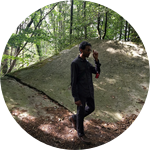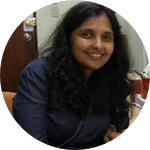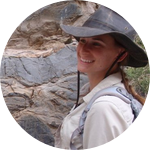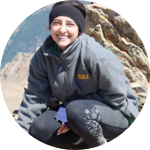About This Project
Our team aims to map and sample serpentine rocks and their related soils in Sri Lanka. These rocks originate from deep in the Earth and we want to characterize them in order to understand their origin and role in the regional geologic history. This will provide more information for local communities, inform the geologic history of the region, and provide context for serpentine bodies found elsewhere on Earth as well as on other planets like Mars.
Ask the Scientists
Join The DiscussionWhat is the context of this research?
In Sri Lanka, at least four serpentine bodies have already been discovered and their locations have been documented (Vithanage et. al., 2014) . The serpentine bodies are found along the boundary of two major rock bodies in Sri Lanka that were pushed together 600 million years ago (Mathavan et. al., 1999). However, the history of the serpentine bodies and their relationship to the surrounding rocks remains poorly known. In addition, the soils that develop from these rocks are a hazard, containing high concentrations of heavy metals that can contaminate groundwater and inhibit plant growth. With our work, we hope to contribute to our understanding of the fundamental geology of the region, and provide more data and observations to help quantify the threat posed by these soils.
What is the significance of this project?
Greater characterization of these serpentinite bodies will shed light on how Sri Lanka fit into the Gondwana supercontinent assembly ~600 million years ago. While small, Sri Lanka likely fit between the larger portions of the Gondwana assembly, and can inform the arrangement of the other continents (Mathavan et. al.,1999). Furthermore, the soils on these bodies are a present concern for local populations (Vithanage et. al., 2014), and characterization of soil compositions provides more data to aid local planning and management strategies. An additional interest for our group is providing greater context on the serpentine bodies seen on Mars by expanding our understanding of terrestrial serpentine bodies.
What are the goals of the project?
The primary goal for our project is to characterize Sri Lankan serpentinites in order to understand their history and relationship to surrounding rocks. To do this we will collect samples of rocks and soil from these serpentine bodies. In addition, we will also map their apparent exposure on the ground for comparison with satellite images. Upon return from Sri Lanka, microscopic (petrographic and cathodoluminescence) and geochemical (XRF, EMP, XRD ) observations will be combined to texturally, chemically, and mineralogically characterize Sri Lankan serpentines and learn about their history. Our field mapping will be compared with visible and infrared images of the bodies to characterize their spectral signature, and look for undiscovered outcrops.
Budget
Thanks to support from our lab, we have funds available that can cover our airfare to the country. However, we still need field supplies (notebooks and sample bags) as well as safety supplies such as mosquito nets and protective snake gear. We also need to ship our samples back to the US for analysis, which can cost up to $5 per pound of material. For all this, we budget $600, about half for the supplies and half for sample shipment. Renting a car to reach the sites will cost $450, and living expenses for both of us for one week will cost $1400. To travel safely, we need protection from tropical diseases while in the country, so we request $220 to cover these medications. Finally, Experiment.com charges a platform fee, we include this here so you know exactly how much of your donation goes directly to the science!
Endorsed by
 Project Timeline
Project Timeline
Until we leave on August 2nd, we will be planning and preparing for our field mission to Sri Lanka. We will spend a week there, visiting sites and collecting samples and other field data. Samples will have to be shipped back, which will take some time to return to the US. Upon the return of the samples, we will begin preparing the samples for examination and getting our first look at the samples. Initial results will be shared at the 2019 Lunar and Planetary Science Conference
Jul 12, 2018
Start Experiment.com Campaign
Jul 12, 2018
Project Launched
Aug 02, 2018
Depart for Sri Lanka
Sep 01, 2018
Samples returned from Sri Lanka
Nov 01, 2018
Complete initial characterization of samples
Meet the Team
Don Hood
I am a 4th year Ph.D. Candidate at LSU, getting my Doctorate in Geology studying planetary science. In my research, I focus on the martian surface, and how we can understand its history based on the surface chemistry and mineralogy. However, since I am stuck here on Earth, I also like to study locations on this planet that may be similar to those that once existed on Mars, often called "martian analogs". Even the most remote places on Earth are nextdoor compared to Mars, making these analogs much easier to study. The thing about my work that excites me most is that, when we do research, we get to make discoveries and find a truth that nobody has known before. I hope that we can do that in Sri Lanka, and truly discover something new about the history of these rocks.
Allison K Barbato
I’m a recent graduate from the Louisiana State University (LSU) geology program, and I've always had a love for research, the outdoors and photography. My research projects have spanned across multiple, diverse fields including planetary science, sedimentology and surface process, and metamorphic geochemistry . I've enjoyed representing LSU and presenting my work at multiple conferences around the country.
When people ask me where I’m from I simply tell them I’m not from anywhere, but I was born in Lafayette, Louisiana. When I was 3 years old my family moved overseas for 15 years. I became a global nomad, living in multiple countries around the world including Balikpapan, Indonesia, Jakarta, Indonesia, Houston, Texas, Rio de Janeiro, Brazil, the Hague, the Netherlands, and Cairo, Egypt. By living abroad, I was constantly adapting to various cultures and different ways of life. Learning to acclimate through diverse environments has helped me grow as a student and approach difficulties with an open mind and the determination to overcome challenges.
Additional Information
As a thanks for your support, backers who support us at $50 or more will get to name a sample from our study! We will send you a picture of the sample, and use the name you give in all publications. Backers who support us at higher levels can name one sample for every $50 of support (i.e. $150 = 3 named samples). Since this will be published work, we reserve the right to decline names that are inappropriate for publication.
Project Backers
- 39Backers
- 100%Funded
- $2,895Total Donations
- $74.23Average Donation






